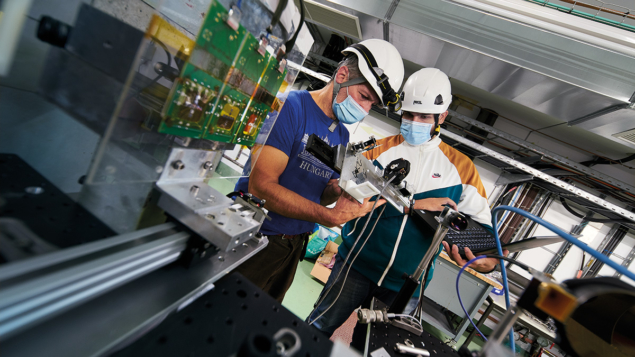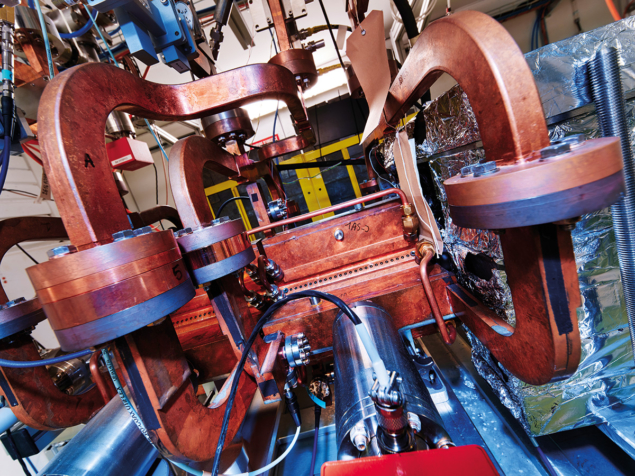Built in response to the low availability of test-beam facilities in Europe, the CERN Linear Accelerator for Research (CLEAR) serves as a unique facility for R&D towards accelerator technologies for science and society. Luke Dyks and Roberto Corsini present highlights and future activities.

Particle accelerators have revolutionised our understanding of nature at the smallest scales, and continue to do so with facilities such as the LHC at CERN. Surprisingly, however, the number of accelerators used for fundamental research represents a mere fraction of the 50,000 or so accelerators currently in operation worldwide. Around two thirds of these are employed in industry, for example in chip manufacturing, while the rest are used for medical purposes, in particular radiotherapy. While many of these devices are available “off-the-shelf”, accelerator R&D in particle physics remains the principal driver of innovative, next-generation accelerators for applications further afield.
The CERN Linear Electron Accelerator for Research (CLEAR) is a prominent example. Launched in August 2017 (CERN Courier November 2017 p8), CLEAR is a user facility developed from the former CTF3 project which existed to test technologies for the Compact Linear Collider (CLIC) – a proposed e+e– collider at CERN that would follow the LHC. During the past five years, beams with a wide range of parameters have been provided to groups from more than 30 institutions across more than 10 nations.
CLEAR was proposed as a response to the low availability of test-beam facilities in Europe. In particular, there was very little time available to users on accelerators with electron beams with an energy of a few hundred MeV, as these tend to be used in dedicated X-ray light-source and other specialist facilities. CLEAR therefore serves as a unique facility to perform R&D towards a wide range of accelerator-based technologies in this energy range. Independent of CERN’s other accelerator installations, CLEAR has been able to provide beams for around 35 weeks per year since 2018, as well as during long shutdowns, and even managing successful operation during the COVID-19 pandemic.
Flexible physics
As a relatively small facility, CLEAR operates in a flexible fashion. Operators can vary the range of beams available with relative ease by tailoring many different parameters, such as the bunch charge, length and energy, for each user. There is regular weekly access to the machine and, thanks to the low levels of radioactivity, it is possible to gain access to the facility several times per day to adjust experimental setups if needed. Along with CLEAR’s location at the heart of CERN, the facility has attracted an eager stream of users from day one.
CLEAR has attracted an eager stream of users from day one
Among the first was a team from the European Space Agency working in collaboration with the Radiation to Electronics (R2E) group at CERN. The users irradiated electronic components for the JUICE (Jupiter Icy Moons Explorer) mission with 200 MeV electron beams. Their experiments demonstrated that high-energy electrons trapped in the strong magnetic fields around Jupiter could induce faults, so-called single event upsets, in the craft’s electronics, leading to the development and validation of components with the appropriate radiation-hardness. The initial experiment has been built upon by the R2E group to investigate the effect of electron beams on electronics.

As the daughter of CTF3, CLEAR has continued to be used to test the key technological developments necessary for CLIC. There are two prototype CLIC accelerating structures in the facility’s beamline. Originally installed to test CLIC’s unique two-beam acceleration scheme, the structures have been used to study short-range “wakefield kicks” that can deflect the beam away from the planned path and reduce the luminosity of a linear collider. Additionally, prototypes of the high-resolution cavity beam position monitors, which are vital to measure and control the CLIC beam, have been tested, showing promising initial results.
One of the main activities at CLEAR concerns the development and testing of beam instrumentation. Here, the flexibility and the large beam-parameter range provided by the facility, together with easy access, especially in its dedicated in-air test station, have proven to be very effective. CLEAR covers all phases of the development of novel beam diagnostics devices, from the initial exploration of a concept or physical mechanism to the first prototyping and to the testing of the final instrument adapted for use in an operational accelerator. Examples are beam-loss monitors based on optical fibres, and beam-position and bunch-length monitors based on Cherenkov diffraction radiation under development by the beam instrumentation group at CERN.
Advanced accelerator R&D
There is a strong collaboration between CLEAR and the Advanced Wakefield Experiment (AWAKE), a facility at CERN used to investigate proton-driven plasma wakefield acceleration. In this scheme, which promises higher acceleration gradients than conventional radio-frequency accelerator technology and thus more compact accelerators, charged particles such as electrons are accelerated by forcing them to “surf” atop a longitudinal plasma wave that contains regions of positive and negative charges. Several beam diagnostics for the AWAKE beamline were first tested and optimised at CLEAR. A second phase of the AWAKE project, presently being commissioned for operation in 2026, requires a new source of electron beams to provide shorter, higher quality beams. Before its final installation in AWAKE, it is proposed to use this source to increase the range of beam parameters available at CLEAR.

Further research into compact, plasma-based accelerators has been undertaken at CLEAR thanks to the installation of an active plasma lens on the beamline. Such lenses use gases ionised by very high electric currents to provide focusing for beams many orders of magnitude stronger than can be achieved with conventional magnets. Previous work on active plasma lenses had shown that the focusing force was nonlinear and reduced the beam quality. However, experiments performed at CLEAR showed, for the first time, that by simply swapping the commonly used helium gas for a heavier gas like argon, a linear magnetic field could be produced and focusing could be achieved without reducing the beam quality (CERN Courier December 2018 p8).
Plasma acceleration is not the only novel accelerator technology that has been studied at CLEAR over the past five years. The significant potential of using accelerators to produce intense beams of radiation in the THz frequency range has also been demonstrated. Such light, on the boundary between microwaves and infrared, is difficult to produce, but has a variety of different uses ranging from imaging and security scanning to the control of materials at the quantum level. Compact linear accelerator-based sources of THz light could potentially be advantageous to other sources as they tend to produce significantly higher photon fluxes. By using long trains of ultrashort, sub-ps bunches, it was shown at CLEAR that THz radiation can be generated through coherent transition radiation in thin metal foils, through coherent Cherenkov radiation, and through coherent “Smith–Purcell” radiation in periodic gratings. The peak power emitted in experiments at CLEAR was around 0.1 MW. However, simulations have shown that with relatively minor reductions in the length of the electron bunches it will be possible to generate a peak power of more than 100 MW.
FLASH forward
Advances in high-gradient accelerator technology for projects like CLIC (CERN Courier April 2018 p32) have led to a surge of interest in using electron beams with energies between 50–250 MeV to perform radiotherapy, which is one of the key tools used in the treatment of cancer. The use of so-called very-high energy electron (VHEE) beams could provide advantages over existing treatment types. Of particular interest is using VHEE beams to perform radiotherapy at ultra-high dose rates, which could potentially generate the so-called FLASH effect in patients. Here, tumour cells are killed while sparing the surrounding healthy tissues, with the potential to significantly improve treatment outcomes.

So far, CLEAR has been the only facility in the world studying VHEE radiotherapy and FLASH with 200 MeV electron beams. As such, there has been a large increase in beam-time requests in this field. Initial tests performed by researchers from the University of Manchester demonstrated that, unlike other types of radiotherapy beams, VHEE beams are relatively insensitive to inhomogeneities in tissue that typically result in less targeted treatment. The team, along with another from the University of Strathclyde, also looked at how focused VHEE beams could be used to further target doses inside a patient by mimicking the Bragg peak seen in proton radiotherapy. Experiments with the University Hospital of Lausanne to try to demonstrate whether the FLASH effect can be induced with VHEE beams are ongoing (CERN Courier January/February 2023 p8).
Even if the FLASH effect can be produced in the lab, there are issues that need to be overcome to bring it to the clinic. Chief among them is the development of novel dosimetric methods. As CLEAR and other facilities have shown, conventional real-time dosimetric methods do not work at ultra-high dose rates. Ionisation chambers, the main pillar of conventional radiotherapy dosimetry, were shown to have very nonlinear behaviour at such dose rates, and recombination times that were too long. Due to this, CLEAR has been involved in the testing of modified ionisation chambers as well as other more innovative detector technologies from the world of particle physics for use in a future FLASH facility.
High impact
As well as being a test-bed for new technologies and experiments, CLEAR has provided an excellent training infrastructure for the next generation of physicists and engineers. Numerous masters and doctoral students have spent a large portion of their time performing experiments at CLEAR either as one-time users or long-term collaborators. Additionally, CLEAR is used for practical accelerator training for the Joint Universities Accelerator School.
Numerous masters and doctoral students have spent time performing experiments at CLEAR
As in all aspects of life, the COVID-19 pandemic placed significant strain on the facility. The planned beam schedule for 2020 and beyond had to be scrapped as beam operation was halted during the first lockdown and external users were barred from travelling. However, through the hard work of the team, CLEAR was able to recover and run at almost full capacity within weeks. Several internal CERN users, many of whom were unable to travel to external facilities, were able to use CLEAR during this period to continue their research. Furthermore, CLEAR was involved in CERN’s own response to the pandemic by undertaking sterilisation tests of personal protective equipment.
Test-beam facilities such as CLEAR are vital for developing future physics technology, and the impact that such a small facility has been able to produce in just a few years is impressive. A variety of different experiments from several different fields of research have been performed, with many more that are not mentioned in this article. Unfortunately for the world of high-energy physics, the aforementioned shortage of accelerator test facilities has not gone away. CLEAR will continue to play its role in helping provide test beams, with operations due to continue until at least 2025 and perhaps long after. There is an exciting physics programme lined up for the next few years, featuring many experiments similar to those that have already been performed but also many that are new, to ensure that accelerator technology continues to benefit both science and society.





